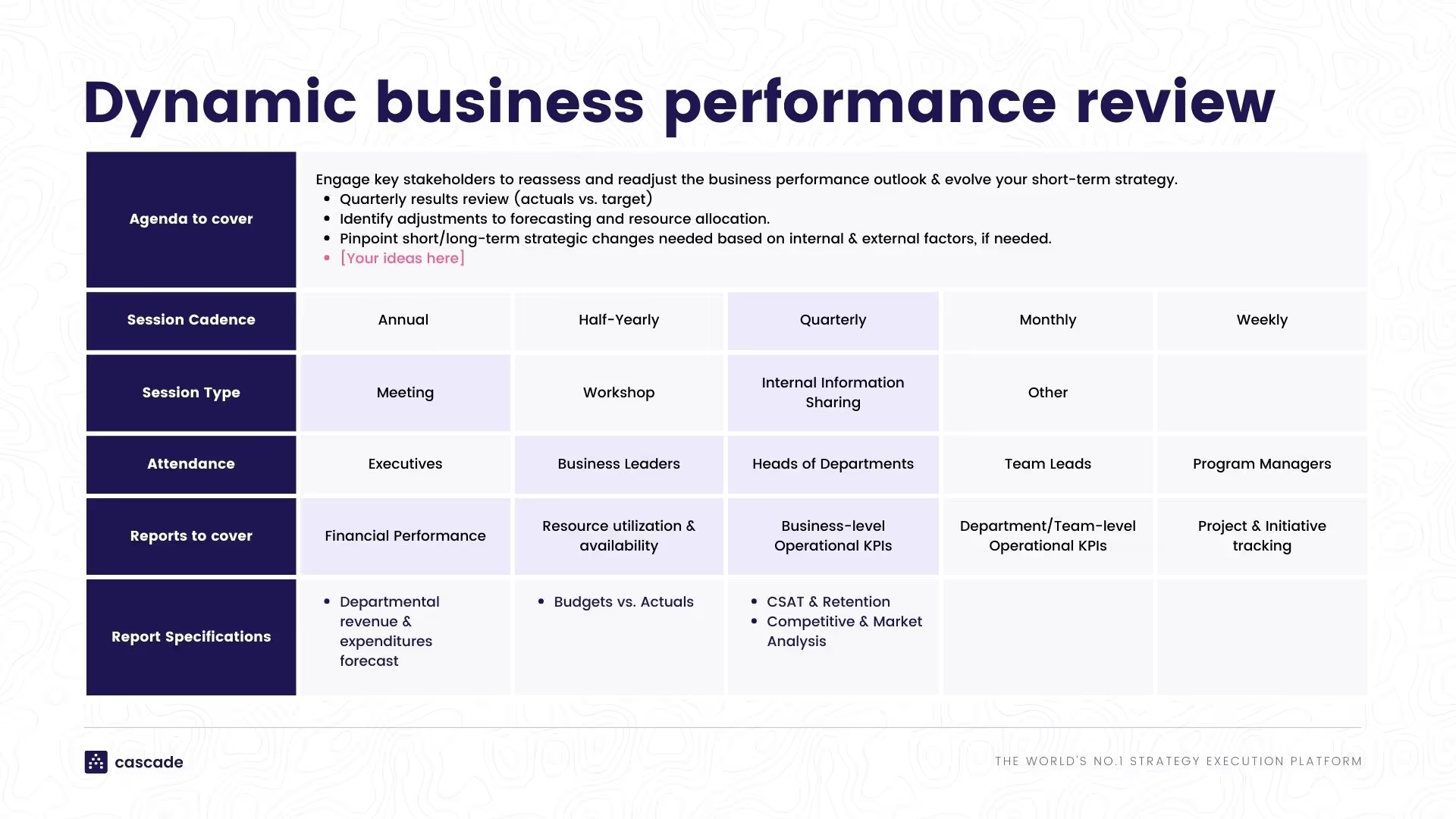The process of strategy evaluation is often overlooked in the overall strategic management process. After the flurry of activity in the initial planning stages, followed by the reality check of executing your strategy alongside business-as-usual, strategy evaluation is often neglected.
When this happens, strategies quickly become outdated and out-of-sync with the changing face of the organization.
On the contrary, when an efficient strategy evaluation process is set in place, businesses can benefit from insights and learnings from past performance to inform more efficient decision-making.
What Is Strategy Evaluation?
Strategy evaluation is the process of analyzing a strategy to assess how well it's been implemented and executed. It’s an internal analysis tool and should be used as part of a broader strategic analysis for the organization when making strategic decisions.
Typically, the strategy evaluation process involves answering questions such as:
- Are we moving forward towards achieving our core business metrics?
- How much progress have we made towards our Vision?
- Are our Strategic Focus Areas still relevant?
- Which of our Objectives have we completed?
- Do we have sufficient Projects to deliver incomplete Objectives?
- Are our KPIs still effective for measuring progress towards our Objectives?
- Where did we fall short of our targets? Why did this happen?
At the very least, you need to evaluate your strategy twice a year—or better yet, every quarter. Even if you feel as though your existing company strategy is 'too far gone' and needs a fresh start, you'll want to perform a thorough strategy evaluation to understand what went wrong and use this information for your new strategy.
The mistake that people often make when it comes to strategy execution, is thinking of their strategy as a linear set of steps. In reality, the strategic planning process requires constant iteration and evolution, with strategy evaluation serving as a pivotal factor in shaping strategy formulation.
💡Pro Tip: A good strategy should never really 'end'. Rather, it should morph into something more ambitious and sophisticated as goals are met.
Steps For a Successful Strategy Evaluation Process
There is no one-size-fits-all in terms of strategy evaluation, so we encourage you to think about how your own process would look like. However, after working on countless strategies with our customers, these are the steps we suggest you follow for a successful evaluation process.
📹 Watch this episode of The Ultimate Strategy Podcast to learn how reflection drives strategy evaluation and continuous improvement, with insights from Laura Blackmore and Devina Patel:
Step 1: Evaluation starts at the start
It may sound counter-intuitive, but ideally, you'll be kicking off your strategy evaluation process back in the planning stage. Strategy evaluation is essentially the process of figuring out:
- What did we do well?
- How can we improve upon what we did well?
- What did we learn about ourselves and the external environment along the way?
One of the best ways to answer these questions is by setting effective KPIs (Key Performance Indicators) in your planning stage so you’ll be able to clearly measure performance in the following stages.
Let’s look at an example:
Imagine "EcoWise," a company with a vision to lead global sustainable living. One of their core business metrics is market share, and they aim to expand their eco-friendly products into new international markets.
One of their focus areas could be “International Market Expansion” driven by the following objectives:
- Enter and secure a 5% market share in Europe.
- Launch at least five new eco-friendly products annually.
To understand progress towards the objectives, they set the following KPIs:
- Market Share Growth
- Product Adoption Rate
- Sustainability Ratings
By having clear KPIs that set a benchmark and allow to measure actual results, EcoWise will be able to answer fundamental questions during the strategy evaluation process:
- Did we meet our KPI?
- Why did we fall short?
- Was this even the right KPI?
👉🏻 How Cascade can help?
With Cascade’s planner feature, you can ensure you set all the important elements of your strategic plan with structure and ease and assign measurable targets at the initiative and project levels.
%2520(1).avif)
Step 2: Implement consistent processes and tools
Not to sound too much like a broken record, but effective strategy evaluation requires planning that goes beyond the setting of good KPIs. You'll also need to plan out your 'strategy rhythm'—things like:
- How often will we measure progress against our goals?
- What standardized set of reports will be used throughout the business?
- What level of detail shall we capture in our written commentary on progress against the plan?
💡Pro Tip: It’s important to determine these types of things up front and implement a regime of meetings and reports throughout the organization.
We like to call this process your 'strategy rhythm' as it should form the backbone of your organization's activities, and be maintained regularly and consistently throughout the year.
Here is an example you can use provided by Cascade’s team of experts:

Step 3: Empower teams to evaluate their own strategies
Empowerment plays a critical role in the strategy evaluation process. Rather than have the leadership team alone participate in your strategy evaluation, invite stakeholders from different areas and departments to prepare their own evaluation of how the team performed against the strategy.
Provide them with a simple framework to conduct the analysis and address essential questions like:
- Did we meet our goals?
- What was it that helped us to succeed?
- What challenges made us fall short?
- Were our goals well set, and have they brought us closer to achieving our overall vision?
Ideally, you'll have your teams present using the tools you defined in step 2. This includes any strategic dashboards or standardized reports that you agreed on previously.
.jpeg)
👉🏻 How Cascade can help?
Cascade’s dashboards and reports in real-time give you and your teams an accurate picture of the strategic performance to aid in your strategy evaluation process.
Step 4: Take corrective action
Steps 4 and 5 (below) are somewhat intertwined and should be performed largely in conjunction with each other. If you find that you're not meeting one of your goals, you'll want to do two things:
- Start by figuring out if the goal is still the right one.
- If it is, take corrective action to address any shortcomings.
Assuming you're still convinced the goal you've set is the right one, you need to implement an action plan to get yourself back on track.
There are many reasons why you might be struggling to hit your goals, ranging from relatively simple issues such as:
- Lack of resource allocation (human or financial)
- Conflicting priorities
- Ineffective tracking of targets
- Misalignment or understanding of the goal
Or your challenges may be more complex and relate to:
- Increased competition
- A significant capital shortfall
- Regulatory pressures
- Lack of internal innovation
Whatever the case, the sooner you can identify these issues, the sooner you can start to take corrective action to ensure a more effective strategy implementation that will get you closer to achieving your desired results.
How to identify the issue?
There are tools and frameworks you can use during the strategy evaluation process that can give you more information about internal and/or external factors that may be hindering your progress.
For example, a SWOT analysis can be useful to reveal what you excel at and where you need improvement. Identifying your weaknesses is key to understanding what might be holding your strategy back.
Another best practice is conducting a competitive analysis to gain insights into what your competitors are doing better. By comparing your strengths and weaknesses against theirs, you can understand where you hold the competitive advantage and where you have gaps that need addressing.
Step 5: Iterate your plan
There are two scenarios where you'll want to iterate your plan as part of your strategy evaluation—one being significantly more positive than the other:
Scenario 1: When you achieve your goals
In an ideal world, your plan evolves because you've successfully checked off some or all of your strategic goals. Your plan isn't set in stone; it's flexible and can take unexpected turns.
For instance, you might reach certain goals much earlier than anticipated. When that happens, you shouldn't wait around for the entire plan to play out. Instead:
- If you've met all your goals, it's time to ask if your broader focus area is complete. If not, it's time for new goals within that focus area.
- Or, if you've successfully nailed all your focus areas, it's time to ponder if you're closer to your vision. If not, new focus areas should come into play.
Scenario 2: When you fall short of your goals
Now, let's consider a different scenario, where you didn't quite hit all your goals. But here's the thing: just because you missed a goal doesn't automatically mean you need to take immediate corrective action.
One of the key outcomes of effective strategy evaluations is the recalibration of Key Performance Indicators (KPIs).
Going back to the example in step 1, let’s say that EcoWise effectively launched 5 new products, but this did not effectively translate into them gaining significant market share (which was the key metric they were aiming for).
In this case, it suggests the original KPI might not have been quite right. But you wouldn't have known that without either the KPI in the first place or the process of strategic evaluation.
👉🏻 How Cascade can help?
The platform allows for a flexible setup of your strategy to easily make changes to the plan if needed after the insights learned from your strategic evaluation process. By providing full visibility, your teams and other stakeholders will be aware of the changes in real-time!
Step 6: Celebrate successes
We've saved the most fun part of the strategy evaluation process for last—celebrating success.
Given that your strategy will never ‘finish,’ it’s important to celebrate the successes along the way to keep your teams motivated and engaged. The first time you achieve a KPI or even focus areas—enjoy it!
Celebrating the success of a strategic goal is not only great for morale, but it also sends a strong message that the execution of the plan really really matters.
Strategy Evaluation Framework Example
Let's imagine how a supply chain company could tackle the evaluation of its quarterly supply chain plan:
- KPIs analysis: First, they examine their KPIs to decipher which goals they've attained and which ones are still a work in progress.
- Team performance report: The teams get to work on crafting performance reports, offering insights into their achievements and areas requiring additional focus.
- Further analysis: When certain KPIs fall short, they conduct a deeper analysis to uncover the root causes of these performance gaps. In some cases, they even realize that the initial KPIs might not have been the best fit.
- KPI evolution: If they’ve successfully met a KPI, they adapt and introduce a new one to further advance toward key business metrics.
- Evolving the plan: With insights and learnings from their strategy evaluation, they refine their strategic plan, making tweaks and adjustments as needed.
Centralized Observability: The Key To Effective Strategy Evaluation
In the realm of strategic business management, the journey to success is all about adaptability, evolution, and continuous improvement. A pivotal aspect of this journey is the capability to gain a holistic, centralized view of your strategy.
Centralized observability plays a pivotal role in successful strategy evaluation, empowering organizations to:
- Monitor KPIs and goals in real time.
- Understand how teams work together toward achieving the overarching business goals.
- Quickly spot areas that may need adjustments.
- Foster a culture of transparency and accountability, as teams can see how their efforts impact the broader strategy.
This unified perspective simplifies the process of assessing strategy effectiveness and provides invaluable insights for more effective decision-making.
This is where Cascade, the world’s leading Strategy Execution Platform, comes into play as your strategic ally. Cascade enables centralized observability by offering key features for goal management, performance tracking, and strategy alignment. It streamlines the strategy evaluation process, providing real-time data for confident decision-making.
Discover how Cascade can help! Sign up today for free or book a guided 1:1 product tour with one of Cascade’s in-house strategy execution experts.



.avif)

.png)
.jpg)
.jpg)
%20(1)%20(1)%20(1)%20(1)%20(1).png)



